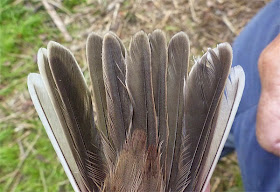With all the excitement of the weekend and the Pallas's Grasshopper Warbler I didn't get around to posting an update of the weekends ringing at the Haven. The weekend was very much one of two halves, Saturday was another busy day with 233 new birds ringed, whilst Sunday was more relaxed with only 137 new birds ringed. There were in fact several highlights besides the obvious one, the first was the capture of three Kingfishers in a day, the first time we have done that.
 |
| Juvenile Common Kingfisher |
 |
| Three Juvenile Kingfishers |
The next highlight was the capture of two Common Redstarts, our first of the year. Barry had decided to put a Redstart tape on in the morning, it had obviously been worthwhile. Both birds were juvenile birds, and both were males, the black throat feathers can be seen coming through the strongly buff fringed feathers on the image below.
 |
| Juvenile Male Common Redstart |
Of the 233 birds ringed 91 were Blackcaps, our best day of the year for this species, 32 were Common Whitethroat, 30 Sedge Warbler and 20 each of Grasshopper Warbler and Reed Warbler. Willow Warbler numbers remained good with 10 new birds and 10 new Chiffchaffs were also caught. Only four new Garden Warblers were added to our total to date of 64, which has now surpassed last years total of 63.
I have previously posted on the subject of ageing Common Whitethroats and in particular the colour of the iris which is quite often the first indication of age. The bird below posed an interesting conundrum, as on first impression the eye looked decidedly juvenile. But on closer inspection its was possible to see a retained worn adult secondary feather in the wing. In addition extensive white was present in the outer tail feathers, these features pointing to an adult.
 |
| Adult Common Whitethroat - although the iris is obvious, it is considerably darker than most adults. |
 |
| Common Whitethroat - Note retained worn adult secondary in the wing |
 |
| Common Whitethroat tail, note extent of white on outer edge of the outer tail feathers and on the tips of the fifth and fourth tale feathers |
As I have already mentioned, Sunday was a completely different day with only 137 new birds ringed. The most numerous species was again Blackcap, with 68 new birds ringed, Reed Warbler was next with 30 new birds, followed by Sedge Warbler with 26. Only two each of Grasshopper Warbler and Common Whitethroat were ringed, and our third Lesser Whitethroat of the year.
No comments:
Post a Comment